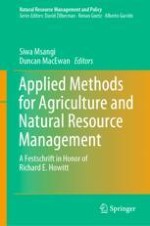This book assesses recent developments in the analysis of agricultural policy and water resource management, and highlights the utility and theoretical rigor of quantitative methods for modeling agricultural production, market dynamics, and natural resource management. In diverse case studies of the intersection between agriculture, environmental quality and natural resource sustainability, the authors analyze economic behavior - both at aggregate as well as at individual agent-level - in order to highlight the practical implications for decision-markers dealing with environmental and agricultural policy. The volume also addresses the challenges of doing robust analysis with limited data, and discusses the appropriate empirical approaches that can be employed. The studies in this book were inspired by the work of Richard E. Howitt, Emeritus Professor of Agricultural Economics at the University of California at Davis, USA, whose career has focused on the application of robust empirical methods to address concrete policy problems.
